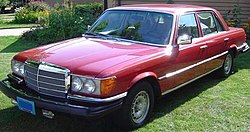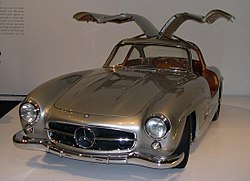Mercedes 35 hp
The Mercedes 35 hp was a radical early car model designed in 1901 by Wilhelm Maybach and Paul Daimler, for Emil Jellinek. Produced in Stuttgart, Germany by the Daimler Motoren Gesellschaft (DMG), it began the Mercedes line of cars which was the predecessor of the Mercedes-Benz automobiles of the Daimler-Benz (since 1926), the company which merged again in 1998 to become the DaimlerChrysler.
Unlike the previous generation of automobiles, which were modified stagecoaches, the Mercedes 35 hp is regarded nowadays as the first car like the modern ones [1]: it bore a powerful petrol engine, it was both wider and larger with a tailored steel chassis, and its center of gravity was near the ground. Originally designed as a racing car, the Mercedes 35 hp was also made for normal road use.
History
Daimler Motoren Gesellschaft (DMG)
DMG was a car company based in Cannstatt, Stuttgart, as the expansion of a previous company which was owned and run by Gottlieb Daimler and Wilhelm Maybach, who had also revolutionized the motor world by introducing the petrol engine and patenting many other things. DMG built automobiles using the Daimler and Maybach's DMG-Phoenix engine of 8 hp with 4 cylinders, first built in 1894, which had also been successfully used in many of the early European car races.
Wilhelm Maybach
In the 19th century, Wilhelm Maybach's career as an industrial designer had been with Gottlieb Daimler in their Cannstatt workshop, at which together they had pioneered the petrol engine production and were responsible for designing and making some of the world's first automobiles. By 1900, Maybach was the Chief Engineer within the DMG, which had been originated from their workshop, although never he got along with the new capitalist board. Also in 1900, Gottlieb Daimler died and his son Paul had taken his place beside Maybach.
Emil Jellinek
Emil Jellinek was a wealthy Austrian businessman and Austro-Hungarian diplomat living in Nice on the French Riviera. His ten year old daughter was named Mercedes, from the Spanish word meaning mercy, given to her to commemorate her French mother's Sepharadi family background. Jellinek used to name his possessions after her, such as his mansions, the automobiles he sold, his racing car team, etc. He himself was often known as Monsieur Mercedes.
| | Adriana Manuela Ramona Jellinek called Mércédès |
Development
Mercedes 35 hp (1901)
|
| Overall stability at high speeds: Large wheelbase. Wide track. Low center of gravity (lower engine). |
| 75 km/h (45 mph). 35 hp (950 rpm). Engine speed 300 to 1000 rpm. |
| Light high performance engine: 4 In Line cylinders. Bore/stroke ratio: 116x140 mm. Displacement: 5918 cc. Cylinder heads part of the castings. Two carburetors, one for each cylinder-pair. Driver-controlled intake-valves's throttling. Two camshafts. |
| Low-voltage magneto ignition. |
| Aluminium crankcase (pioneer), horizontally divided. |
| 4-forward/1-reverse transmission. |
| Lower weight : Press steel framework. Lightweight metals. Trimmed amount of frames. |
| Honeycomb radiator. |
| Comfortable wheel-drive. |
As an avid fan of the DMG brand, Jellinek had signed up two DMG-Phoenix, the predecessor of the Mercedes 35 hp, for competing in the 1900 Nice-La Turbie race (March 30), introducing the Mercedes name then, after his own daughter, for both his racing team and its cars. A tragedy ensued when the chief mechanic of the DMG, Wilhelm Bauer who raced one of the cars, was killed after the first curve of the race. Consequently, the DMG canceled all further involvement in motorsport.
Nonetheless, Jellinek persuaded the DMG for the design of a new model for competing again. 36 of these cars would be delivered, for the large sum of 500,000 goldmarks. He insisted that the powerful engine should be developed by both Maybach and Paul Daimler and be named Daimler-Mercedes, after his daughter. Such renaming was granted because the Daimler brand of the DMG had been already conceded to the French Panhard carmaker for all France. Furthermore, Jellinek specified revolutionary improvements. Unlike the previous generation of cars, unstable motorized coaches of narrow high bodies which were so prone to overturn, the novel Mercedes should be longer, wider, and of a lower center of gravity. Also it would have a light steel body and strong chassis, onto which the engine would be firmly fixed near the ground and lowering the car's center of gravity.
In 1900, over the following months Jellinek oversaw the process closely at first through daily telegrams and traveling personally subsequently. Maybach tested the new car for the first time on November 22 and Jellinek received his first delivery on December 22, 1900.
Further Development
In January 1901, Emil Jellinek's Mercedes team tested six of the new Mercedes 35 hp in the Grand Prix de Pau, but the racecar was of a disappointing performance by multiple technical complications and enduring just for few laps. However in the Nice-La Turbie event of March 1901, it was much different. Jellinek participated through five Mercedes 35 hp and the German driver Wilhelm Werner. The cars dominated the race from start to finish with a record average speed of 51.4 km/h (30 mph), beating the previous 31.3 km/h (20 mph) and reaching top speeds of 86 km/h (55 mph). Those results easily outclassed all other competing cars in any capacity. The automotive world was so astonished that Paul Meyan, director of the French Automobile Club, stated: "We have entered the Mercedes era".
In Stuttgart, DMG mounted two additional back seats on the Mercedes-35hp, transforming it for a family car. Between March and August 1901, it manufactured two more Mercedes models, the 12/16 hp and the 8/11 hp. The Mercedes was so successful that the production lines of the DMG ran at full capacity. The Mercedes trademark was used on DMG production automobiles from June 23, 1902, to 1926. It was formally registered on September 26, 1902.
In June 1903, Emil Jellinek changed his own name to Jellinek-Mercedes, stating: "This is probably the first time that a father has taken his daughter's name".
Often confused with this Mercedes automobile brand are the cars of the Daimler-Benz company, formed in a 1926 merger of DMG and Karl Benz's Benz & Cie., which were called by a new brand name, Mercedes-Benz, regardless of in which plant they were produced after the merger. A commitment was made for the two companies to remain together until 2000. Mercedes-Benz has endured as one of the world's great brands and is now the property of DaimlerChrysler. Over nineteen million automobiles have been sold using that brand name. In 2007 it was announced that the Chrysler portion of the corporation was up for sale.
Technical description
Dimensions
The Mercedes 35 hp had a wheelbase of 2.345 metres and a track of 1.400 metres. Its wooden wheels were all the same size.
The total weight was also dramatically reduced to 1,200 kg by making the main chassis frame of pressed steel of carefully designed U-shaped cross section.
The relatively light engine (230 kg, 34.3 kilograms/hp) was mounted over the front axle without any extra sub frames and, so, its center of gravity was closer to the ground.
Axles
The wooden wheels of the Mercedes 35 hp were non-removable, featuring:
- 12 spokes
- steel covers
- nearly identical pneumatic tires of 910x90-front / 1020x120-rear
There were two braking systems one hand operated and the other by foot.
- The main brake was the hand brake which acted on the rear wheels which had 30 centimeter drums.
- The secondary, foot brake, acted on the chain drive's intermediate shaft and was water-cooled.
Both axles were rigid, equipped with semi-elliptic springs. The steering-axles were designed to minimise transmission of road shocks to the driver.
The steering column was inclined backwards unlike the vertical shaft on many of its contemporaries.
Drive system
The engine of the Mercedes 35 hp was at the front of the car driving the rear wheels through a large roller chain.
The gearshift was at the driver's right side, featuring a gate change system with four forward speeds and a reverse gear. The drum like compact clutch system was attached to the flywheel.
The flywheel consisted of a self-adjustable coil spring made up of wound spring steel. The tension at which the clutch operated was regulated by a conical cam.
Engine
The main bearings were made of magnalium, an aluminium alloy with 5% of magnesium. The crankcase was also made of aluminium.
The four cylinders, cast in grey iron with fixed heads, gave a total displacement of 5,918 cc (bore/stroke: 116x140 mm), and were arranged in pairs each pair with a single spray-nozzle carburetor.
The intake and exhaust valves were no longer opened by cylinder pressure but by camshafts at both sides of the engine driven by gears from the flywheel.
The engine also incorporated:
- low-voltage magneto with make and break spark ignition. This was fitted at Jellinek's demand, replacing the antiquated hot tube system.
- pumped water cooling system
- fan behind the radiator
The engine was started by a hand crank aided by the presence of a decompressor.
Maybach's tubular radiator, patented in 1897, known as a honeycomb radiator, was similar to the present time ones. Its rectangular grille had 8,070 pipes of 6x6 mm each with a square cross section to improve airflow, and holding 9 litres of water. The airflow was assisted by a fan located behind the radiator.
The Mercedes 35 hp engine ran between 300 and 1000 rpm, the speed controlled by the driver using a lever on the steering wheel. Its peak output was 35 hp at 950 rpm.
The road car's average speed was 70-75 km/h (45 mph). The racing version achieved 85 km/h (50 mph).


















![Validate my RSS feed [Valid RSS]](valid-rss-rogers.png)














































































